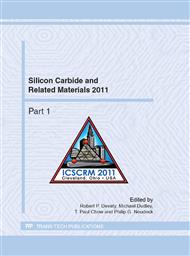p.275
p.279
p.285
p.289
p.293
p.297
p.301
p.305
p.309
High-Resolution Time-Resolved Carrier Lifetime and Photoluminescence Mapping of 4H-SiC Epilayers
Abstract:
We present a comparison between time-resolved carrier lifetime mappings of several samples and integrated near band edge intensity photoluminescence mappings using a pulsed laser. High-injection conditions and as-grown material are used, which generally allow for the assumption of a single exponential decay. The photoluminescence intensity under these circumstances is proportional to the carrier lifetime and the mappings can be used to detect lifetime-influencing defects in epilayers and give an estimate of the carrier lifetime variation over the wafer. Several examples for the defect detection capability of the system are given.
Info:
Periodical:
Pages:
293-296
Citation:
Online since:
May 2012
Authors:
Price:
Сopyright:
© 2012 Trans Tech Publications Ltd. All Rights Reserved
Share:
Citation:


